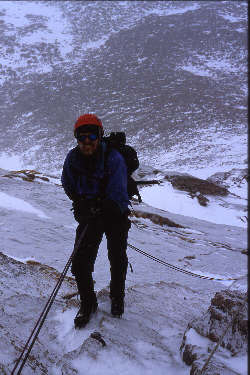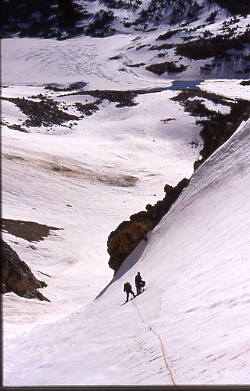|
||||||
|---|---|---|---|---|---|---|
Banff Assiniboine Expedition IIOverview:Bob’s 2003 Canada trip was a success with climbs of three mountains and summits on two of the three. We began with a successful climb of Mount Athabasca, choosing the classic Silverhorn Route as an upgrade over the Normal Route we successfully climbed in 2002. After success on Athabasca, we moved south to Lake Louise to take a second shot at Mounts Haddo and Aberdeen but we were again rebuffed by the steep tongue of the North Glacier. Our final climb was a grudge match growing from last year’s failure to summit Mount Assiniboine. This year, we were only partially successful (placing but two climbers on top), however the climb did provide the invaluable reward of solo leadership experience for one member and a personal best performance for another. Overall, each of us was able to climb peaks demanding the use of new skills developed over the past year or two. For example, this was our second trip onto major glaciers without the assistance of a mountain guide while also including at least one member without prior experience in glacier travel. Additionally, this trip required alpine leads on mixed ground up to 5.5 and again we were successful with at least one member not previously exposed to such climbing requirements. These challenges and others were overcome but not without the lessons one inevitably learns when extending the upper reaches of one’s climbing ability. For our group, this will mean further improving our efficiency and speed, still more practice with old and new techniques and acquiring some additional technical rock gear to better assure success on our next major climbing expedition.
Preparations:Planning for Canada 2003 began months before we packed the truck to head north. It realistically started at the close of our 2002 trip, when we considered a return to Canada to take another shot at the rotten rock of Assiniboine and take on other glaciated peaks in preparation for a possible attempt on Mount Robson in 2004. Regardless of the start point, one thing was evident; improved climbing skills that would be required to summit on routes more challenging than the fourth class Colorado Fourteen’ers. Additionally, there was the never ending need to practice snow skills on local climbs to ensure the safety and efficiency of any trip north. Peak Selection
We learned in 2002 that the Canadians often described the peaks we climbed the previous year as full day climbs. That may mean a good 8 to 10-hour day in Colorado but we learned that their “full day” begins well before sun up and lasts for a minimum of 14 hours. Our target peaks this year were no different, as we planned to do two full day climbs before taking a second shot at Assiniboine, a climb which would entail no less than 3 days if all went exceptionally well. Our trip was also planned to start one week earlier and we were hoping for more seasonable weather. Last year, an unseasonable cold spell came in early August and while some of the peaks were in great shape (Athabasca and Hector), others were covered in verglas (Assiniboine) or routinely avalanching on the popular routes (Andromeda). This year, we were again subject to poor weather but with a bit more experience in peak selection and general climbing conditions, we were wiser about correlating Canadian climb ratings with the degree of difficulty to be expected. So . . . on leaving Cheyenne, our plan was to start with a climb of Mount Athabasca’s “Silverhorn” route. Our next goal was a very full day climb of Victoria, the incredibly beautiful peak that forms the center of the backdrop for Lake Louise. We planned to take a shot at the North Summit, ascending past the teahouse, across the lower glacier and then up the Northeast ridge to the summit ridge. Our final climb called for a second attempt of Mount Assiniboine, the Matterhorn of the Canadian Rockies. We failed in our attempt last summer due to ice on the upper slopes so we were back to challenge this “technical scramble” a second time . . . Mixed Alpine Skills
Our previous climb of the red band on Assiniboine showed that Gary and I both needed the ability to comfortably lead the grade of rock that is common to routes we selected for this trip, generally requiring single pitch proficiency up to a maximum of about 5.5 in plastic boots and crampons. None of us were traditional rock climbers so we had a bit of work to do on the local rocks of the Veedavoo climbing area west of Cheyenne and on some mixed routes in Rocky Mountain National Park. Our goal was simple; develop sufficient skill to surmount the rock bands that would be encountered on a moderate mixed alpine route. We acquired gear and began training in a couple of indoor gyms over the winter before moving outside to Veedavoo once spring arrived. We also opted out of easier summit climbs in the spring, instead taking on routes with technical aspects, which would highlight the skills that we needed to practice. For example, we climbed Longs Peak via the North Face route just before the close of winter and a bit later, the Flying Dutchman Couloir, again on Longs, to practice on extended steep snow and negotiate rock bands requiring belayed climbing.
We also practiced traditional glacier travel skills ranging from climbing steep snow on the couloirs of Medicine Bow Peak to setting up Z pulley systems in preparation for the inevitable crevasse rescue (read either Bolivia 2001 or Canada 2002). The Medicine Bow couloirs provided gentle slopes on which to practice the rest step as well as steep upper reaches allowing roped pitches on up to 70-degree snow. Most importantly, we practiced the efficient construction of belay points similar to those we expected to use on our climbs of Athabasca and Victoria where glacial ice in lieu of snow could make a steep snow pitch an absolute death trap in the event of a falling rope team. This was a lesson hard learned the previous year where a 14-hour effort on Mount Aberdeen gave us the joy of figuring out the approach and the defeat of ascending all of three rope lengths up the tongue of the glacier. The remainder of our snow skill refresher consisted on reviews of roped travel techniques and everyone in the group constructing multiple Z pulley set-ups until the drill was committed to memory. At the conclusion of our training, our experience included two leaders, each with formal avalanche training, glacier travel training, and at least one guided high altitude expedition in addition to over 100 Colorado 14’ers between the two. Our third member had 26 14’ers and guided climbs on both the Grand Teton and Devils tower in his climbing background.
AccommodationsAnother aspect of expedition preparation included making arrangements for transportation to Canada and accommodations in the vicinity of the peaks we planned to climb. We were able to borrow a Suburban for the trip north which gave us the benefit of getting everyone in one vehicle and the opportunity to truck camp in the event we missed out on a camp spot near the Columbia Icefields for our Athabasca climb. For Victoria, we would be camping at Lake Louise which is operates on a non reservation, first come first camped basis. Last year, we ended up splitting the group due to the closure of the campground to tents (bear activity) but since then an electric fence was constructed to divert the grizzlies around the ready food source (us). We did not anticipate problems camping near Lake Louise as Chateau Gravel Pit would also be available. The arrangements for Assiniboine took a bit more effort as we would need transportation into the Assiniboine Lodge at the base of the climb, spots in the climbers hut, and spots at a shelter on the hike out. Last year, we flew in and out by helicopter but this year we wanted enough flexibility to remain an extra day or two to complete this climb so we opted to hike the 17 mile trail back to the car park. We made sufficient reservations to cover for climbing shelter each night at the Hind Hut as well a reserving spots at the Bryant Creek Shelter in case of poor weather on the trip out. GearOur final preparation aspect was accumulating the additional gear required to facilitate rock climbing, acquiring a light weight Megamid shelter for both base camp convenience and the hike out of Assiniboine in the event of rainy weather. Along the same line, we acquired a second ice line (8.1 mm Beal Ice Floss) and also picked up some odds and ends including more wands for glacier travel, maps, and enough film to produce what we hope will be a decent slide show documenting the trip. With these preparations in hand, we gathered at my house in Cheyenne and left on August 1st for the Columbia Icefields, 1400 miles and two days travel distant.
|



